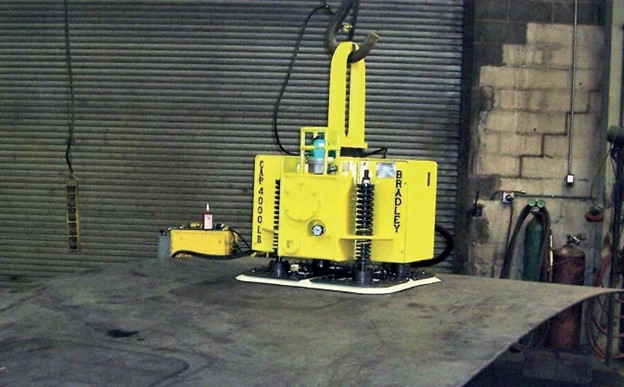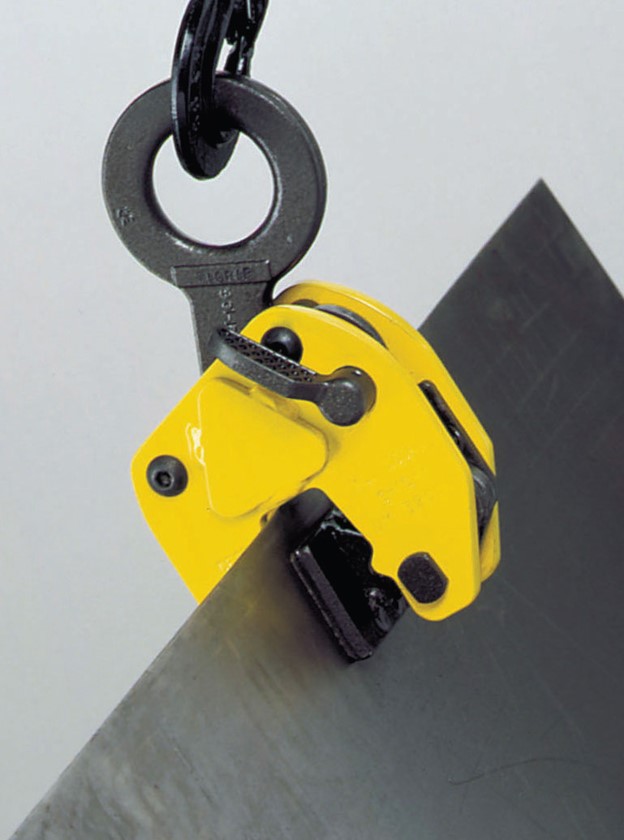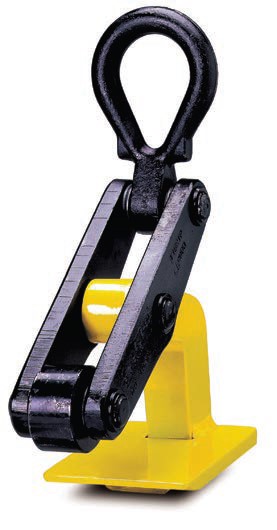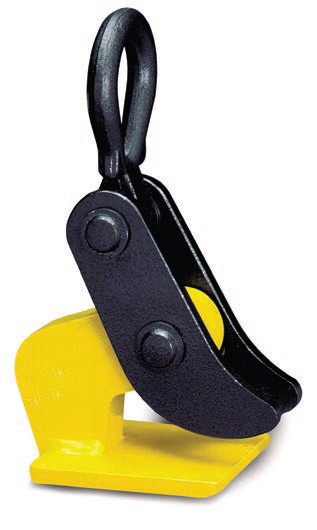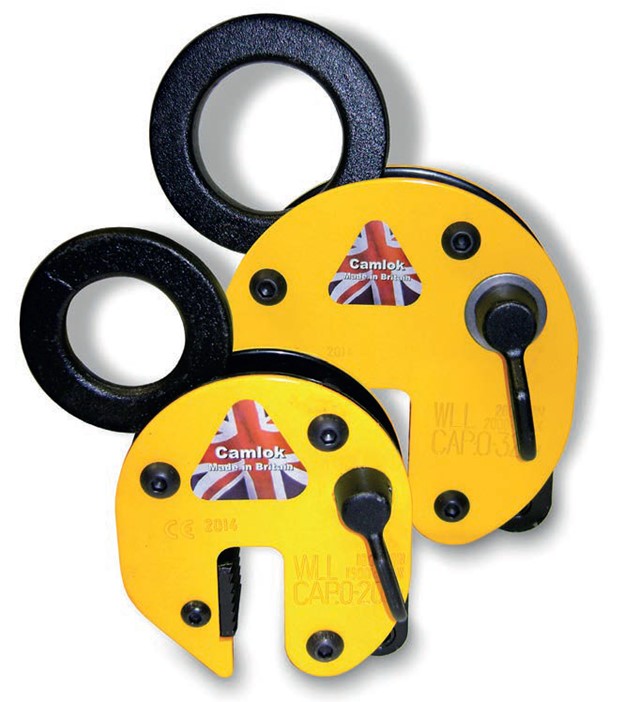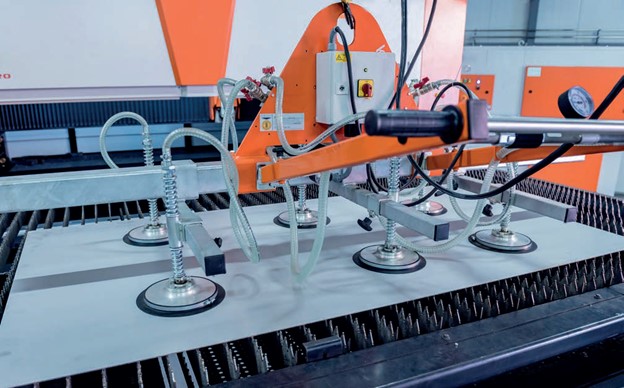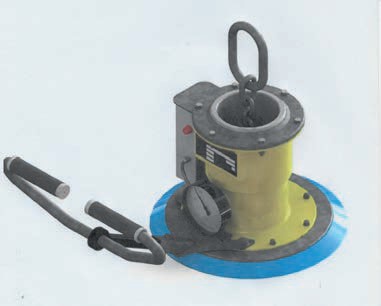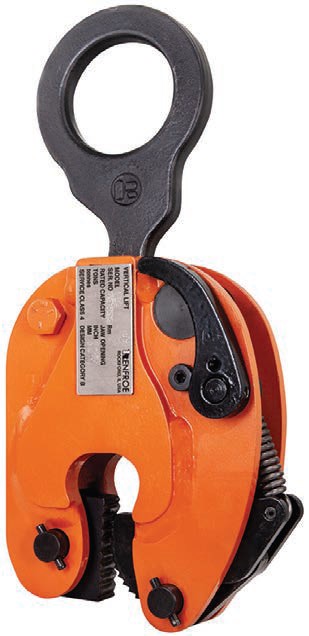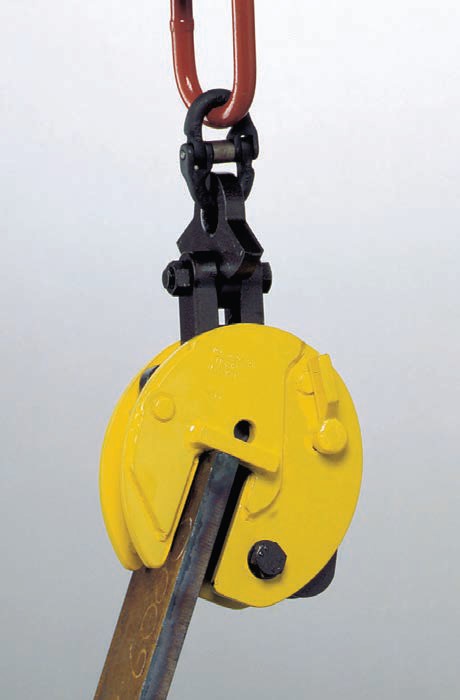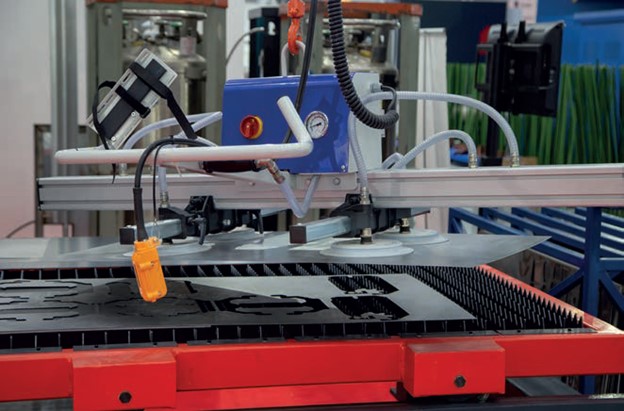Look, no holes...
19 April 2024Flat plates seem to offer no easy attachment points for a hook. But there is a myriad of below-the-hook devices that can lift them. Julian Champkin reports.
A few issues back we described the almost-infinite variety of ways in which that common load – a coil of wire – can be attached to a hook to be lifted. A load almost as common is the flat sheet, of metal or of plywood or of glass, but unlike a coil, a sheet offers no convenient hole to act as a place to grip and lift. Devices for lifting sheets have to therefore attach themselves to the edges, with some sort of mechanical clamp or gripper or lifting ledge, or to the surface, using vacuum pads or, if the load is of steel, magnets. All these approaches work, some better than others according to the application. It is not surprising therefore that there are almost as many below-the-hook devices for lifting flat sheets are there are for lifting coils.
An early distinction can be made: do you want to lift your sheet in a horizontal orientation, parallel to the ground, or set vertically, upright like a windowpane? There are devices for either, and some that will do both.
Camlok, original inventors of the selfweight clamping concept back in 1958, devotes no fewer than nine pages of its 65th-anniversary catalogue to vertical plate clamps, and a further five to horizontal ones – which may be an indication of the relative use of the orientations. Vertical clamps grasp the sheet by the top edge. Working load limits of their various models range from 50kg to 3,000kg; for moving long plates vertically they recommend using two clamps with a spreader beam between them. The same clamps can also be used for lifting and moving constructions – that is, your steel sheets after they have been welded together to form, for example, a vertical box-shape – and for profiles.
Vertical clamps, Camlok’s and others, need some mechanism to close the jaws. On Camlock’s 92-series devices the jaw is opened and closed with a manual locking lever, except for its 92-500, the smallest in their range, with a 50-500kg working load limit, which uses a positive spring loaded cam. The safety lock spring loads the cam jaw, preventing the clamp from opening even when there is no load on the jaw. Jaw openings go up to 32mm, which would be the limiting thickness of the sheet you can lift with them.
Camlok’s CZ series vertical plate clamps are heavier-duty than their 92-series, with WLL up to 30,000kg. They again use a locking lever and spring-loaded safety lock. When lifting vertically, the teeth on such a clamp need to dig in to the steel plate, to a certain extent at least, to give a grip; smooth-surface friction will not generally be enough for safety. For the teeth to dig in, the steel must be slightly malleable. For that reason it is important to note that, for both Camlok ranges, the plate surface of the material being clamped must have a hardness level below HRC 30/Brinell 300. Similar clamps from other manufacturers have similar requirements. Also note that such lifting will of course leave marks, probably visible ones, on the load.
Alternatively, you could use Camlok’s HG (High Grip) plate clamp, which has an extremely high clamping force making the clamp suitable for plate with a surface hardness up to HRC 40/Brinell 375. There is also its TSB non-marking friction plate clamp (WLL 40–1,250kg), which does in this case work through the process of friction, achieved by a special material on the jaw and pad which is similar to brake linings. Another benefit of the TSB is that the same grab can be used for lifting different materials, such as concrete, wood and stone, as well as hardened steel.
Camlok also manufacture the LJ nonmarking plate clamps (WLL 25 – 1,500kg), which have rubber or leather pads according to application and are for structural steel plates, stainless steel, iron, timber and aluminium. They can also be used for steel plates with extremely hard surfaces. An obvious message from that huge variety of non-marking and hard steel devices is that they are highly specialised for particular applications and that it would be wise to take ad-vice before choosing your option – which is exactly what Camlok recommends. Its sales team, they say, will be happy to advise.
There is a similarly wide range in their clamps for lifting sheets horizontally. Here the gripping issue is not so acute. The lower surface of the clamp can provide support without the help of friction. As long as the sheet is rigid, clamps on each side of the sheet can be joined by a two-legged chain sling which will provide the necessary inward force to keep them in place and to toggle the jaws closed. For handling larger plates it is recommended to use two such pairs in conjunction with a spreader beam.
The CH clams have WLL from 1,000 to 10,000 kg; the CH is their industry standard model. Camlok’s horizontal-lift clamps are supplied as standard with smooth jaws. More specialised versions are available. There is the option of hardened steel serrated jaws for special applications; the RH/WH clamps have steel roller set into the jaws for non-marking applications. The ACH has adjustable jaws for lifting stacked plates; and so on.
Of course, Camlok (based in the UK but owned since 1999 by Columbus McKinnon) is far from alone in offering plate-lifting attachments. Tractel have its Topal range, of clamps, beams, and similar below-thehook attachments, and their full range of lifting clamps is similarly wide. They have devices for horizontal and vertical lifting of plates, horizontal transportation of bundles or construction parts, lifting loads with parallel sides such as steel, concrete, wood or plastic, and for lifting smooth and polished materials such as stainless steel and natural stone.
The Topal NX is Tractel’s clamp for lifting horizontal or vertical loads without damaging the surface. As an example application, these clamps have been used in a German plant in painting steel plates. The plates, approximately 4x4m wide and 6mm thick and weighing around 350kg are painted on one side, and once dried the Topal NX clamp allows the damage-free turning of the plates to allow the other side to be painted in turn.
Other devices are available in a variety of configurations and applications, including for maritime and offshore use. The range can be customized and can reach capacities of 500t and beyond.
We have described how horizontal clamps can be kept in position by the pull of the rigging chain that connects them to the hook. To work safely, the sheets that they are lifting must be rigid enough not to bend under that pull. Thinner sheets may sag, under that force and under their own weight, to leave the edges pointing at an angle upwards – which is not ideal for the clamps that are supposed to be holding them. An alternative is to use a more rigid below-the-hook device, of a framework with legs extending beneath it. The legs have flanges at their ends and move in or out to so that the flanges go beneath the load and support it.
Caldwell is one manufacturer of such attachments. Even with these more complex devices there are many variants. Caldwell divides its range into what they call ‘small bundle sheet lifters’ for lightduty handling of smaller size sheets and bundles, “motorised heavy-duty sheet lifters or hydraulic sheet lifters” for bundles, sheets, plates, and other materials stacked horizontally, and “plate lifters” for handling thick plates one at a time.
In the first category its Model 60 is the lightest: the legs are adjusted inwards or outwards by a self-locking worm gear driven by a handwheel turned by the operator. The 60BMS is battery operated; the 60H is hydraulic powered – needing less maintenance that mechanical drives, say Caldwell – and the 60M is driven by mains electricity. They have a model 62, handwheel driven, for lighter duty and smaller sheets, for up to 5t capacity.
All the devices we have mentioned so far have been mechanical. Flat plates are also ideal applications for vacuum lifting and, if they are of steel, for magnetic or electromagnetic lifting. Since we are talking here of plates and sheets in general, including plywood, glass, composites and even stone, we shall leave magnetic lifting to a future article and concentrate here on attachments that can lift plate or sheet made of any material.
Vacuum lifters fall into that category. They are frequently customised and made-to order to clients’ exact needs in terms of size and weight. Bradley Lifting of Pennsylvania designs and manufactures mechanical platelifters, but also just such heavy duty vacuum lifting machines. In their words, “Vacuum lifters are generally used for handling materials that are non-magnetic, thin and difficult to grasp with other lifting devices, susceptible to surface or edge marking or damage, and where single-sheet handling from a stack is required.”
The size and number of vacuum pads of course depends on the weight and dimensions of the load – and loads can be surprisingly heavy and still be safely supported by vacuum. Pipes and curved loads may need specially-shaped rubber or foam edges to the vacuum cups but of course no such issues arise with lifting flat plates. Surface finish and porosity of the load are considerations, but vacuum lifting is surprisingly adaptable: materials of some degree of porosity to air – such as sacks or cardboard, can still be easily handled.
“Multiple Pad Vacuum Lifters are appropriate for lifting materials with large surface areas, significant deflections during a single point lift (such as thin sheets), major changes in area from load to load, or large variations in contour of the lifting surface,” says Bradley. Note the ‘thin sheets’ reference: as we saw, such sheets can pose a problem for lifting by edge clamp, but vacuum lifters can handle them with ease.
“To meet customer requirements their engineers will often incorporate the ability to telescope (manually or by motor) the frame.” Rotation of the load can also be incorporated – the distinction between vertical and horizontal orientation of the sheet that we laboured so much in the earlier part of this article scarcely applies to vacuum lifts. “Factors that must be considered are temperature, porosity of the material and availability of vacuum or power sources on the crane,” says Bradley.
Vacuum lifters of course need to generate their vacuums. The power source for this can be electricity (mains or battery), or an external source of compressed air or of vacuum. German manufacturers Vaculift have a remarkably simple but ingenious method, used in their Green Line series, in which the load itself generates the vacuum that lifts it. The device is a vertical hollow cylinder with a piston inside it. It sits on a sealing ring on the (horizontal) plate to be lifted; the hoist chain is attached to the piston. When the hook and chain move upwards, they pull on the piston, which also moves upwards inside the cylinder – generating a vacuum beneath it, which sticks it to the load and lifts it. If it sounds paradoxical – can you really lift yourself up by your bootstraps? – Vaculift points out that they invented the system themselves, some fifty years ago, and it has been in continuous manufacture, and safe use, ever since, and can lift loads of up to 4t. Vaculift also make more conventional, powered, vacuum lifters: its Red Line electricpowered one which can lift up to 1,250kg with between one and eight pads, Gold Line’battery-powered ones, with turning and pivoting abilities if required, and Blue Line’pneumatically powered models. They also make customised solutions.
Italian specialists Righetti Sollevamenti, based in Verona, make vacuum lifters for sheet metal, stainless steel, aluminium and non-ferrous materials. Their technology has allowed them to create a system of springy and articulated suction cups for sheet metal, which will also adapt to lift not perfectly flat loads, managing to compensate for corrugated or indented surfaces. So, for example, metal sheeting destined for the floor of a walkway, therefore embossed with raised diamond shapes against slipping, can still be lifted by vacuum, specific suction pads with a special gasket that adapts to the surface unevenness.
Righetti make lifters powered by battery, mains electricity, and compressed air. With battery-powered models the client can choose whether he wants to manage suction and release via a manual valve on the handlebar of the lifter, or via a radio remote control. Vacuum monitoring systems ensure safe lifting of the load. Each series of their lifters is available with different lengths of central cross-beams, to accommodate different lengths of load; Righetti also produce customised and tailor-made lifters.
So to lift flat sheets or plates, of almost any material, thickness or size, in whatever orientation you want, you can pick, choose, and consult. You will not be short of options.
